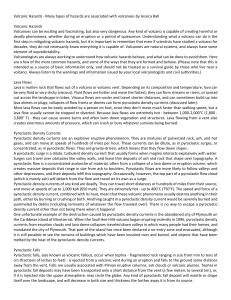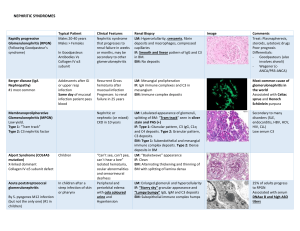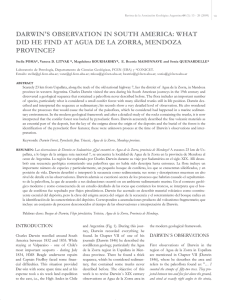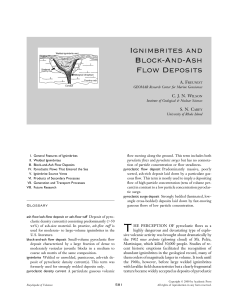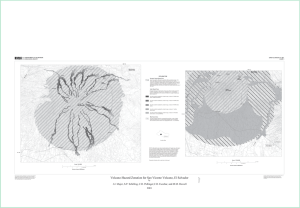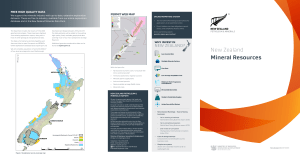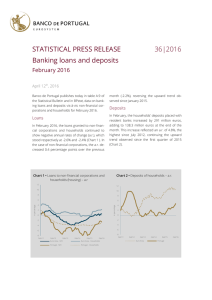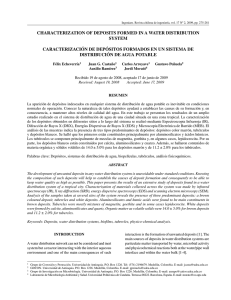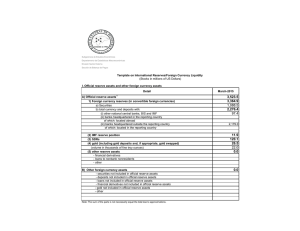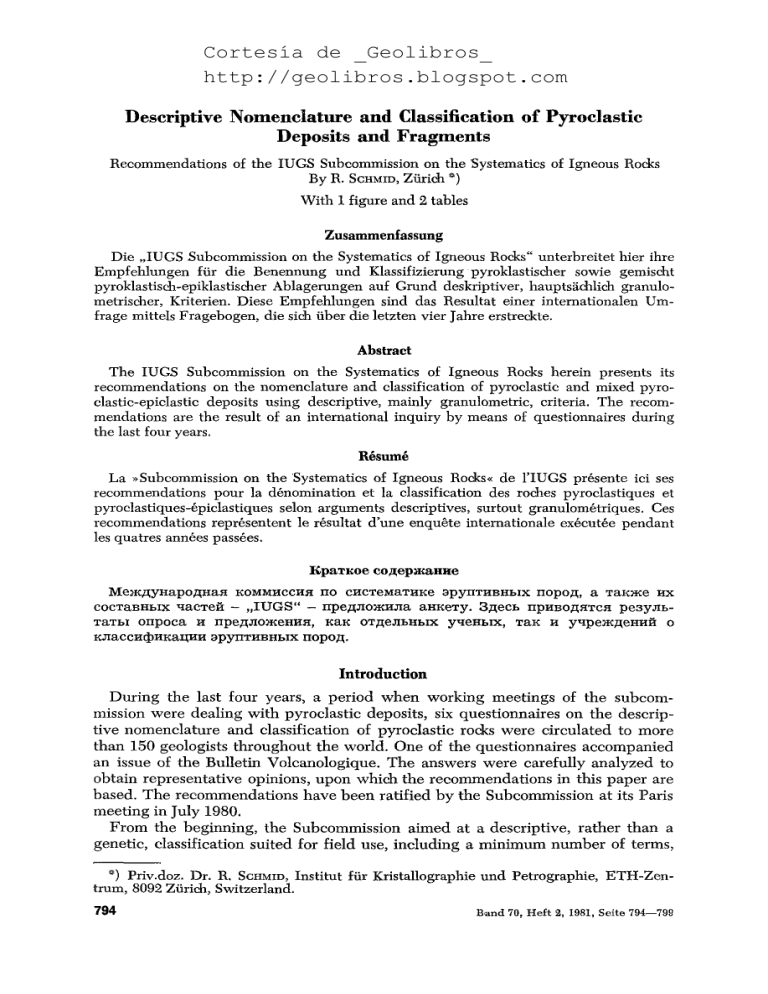
Cortesía de _Geolibros_ http://geolibros.blogspot.com Descriptive Nomenclature and Classification of Pyroelastie Deposits and Fragments 0 Recommendations of the IUGS Subcommission on the Systematics of Igneous Rocks By R. SCHMID,Ziirida *) With I figure and 2 tables Zusammenfassung Die ,,IUGS Subeommission on the Systematics of Igneous Rocks" unterbreitet hier ihre Empfehlungen ffir die Benennung und Klassifizierung pyroklastischer sowie gemischt pyroklastiseh-epiklastischer Ablagerungen auf Grund deskriptiver, haupts~ichlich granulometrischer, Kriterien. Diese Empfehlungen sind das l~esultat einer internationalen Umfrage mittels Fragebogen, die sida iiber die letzten vier Jahre erstreckte. Abstract The IUGS Subcommission on the Systematics of Igneous Rocks herein presents its recommendations on the nomenclature and classification of pyroclastic and mixed pyroclastic-epiclastic deposits using descriptive, mainly granulometric, criteria. The recommendations are the result of an international inquiry by means of questionnaires during the last four years. Rasum~ La ~Subcommission on the Systematics of Igneous Rocks,< de I'IUGS pr6sente ici ses recommendations pour la d6nomination et la classification des roches pyroclastiques et pyroelastiques-6piclastiques selon arguments descriptives, surtout granulom6triques. Ces recommendations repr6sentent le r6sultat d'une enqu~te internationale ex6cut6e pendant les quatres ann6es pass6es. I~paTEoe Co~cp~aHHe Me~yHapo~Haa KOMMHCCHH n o CHCTeMaTHKe 3 p y H T H B H b I X n o p o ~ , a T a I ~ e H x COCTaBHBIX HaCTef~ -- , , I U G S " - n p e ~ a o m H a a a S K e T y . 3~ecr~ r I p H B O ~ T C H p e s y J n ~ - raTbI onpoca ~ npe~aoa~eHx~a, ~aK oT~ea~ris~x y~eHbix, Tare r~ ynpem~enrxf~ o ~aaccr~qb~Ka~Hr~ 3py~TX~BHt,lXnopo~. Introduction During the last four years, a period when working meetings of the subeommission were dealing with pyroclastic deposits, six questionnaires on the descriptive nomenclature and classification of pyroclastic rocks were circulated to more than 150 geologists throughout the world. One of the questionnaires accompanied an issue of the Bulletin Volcanologique. The answers were carefully analyzed to obtain representative opinions, upon which the recommendations in this paper are based. The recommendations have been ratified b y the Subcommission at its Paris meeting in July 1980. F r o m the beginning, the Subcommission aimed at a descriptive, rather than a genetic, classification suited for field use, including a minimum number of terms, ~) Priv.doz. Dr. R. SCHMID,Institut fiir Kristallographie und Petrographic, ETH-Zentrum, 8092 Zfirich, Switzerland. 794 Band 70, Heft 2, 1981, Seite 794--799 R. SCnMID- - Descriptive Nomenclature and Classification and based mainly on the granulometrie properties of pyroelastic deposits. The Subcommission also intended to compile a separate glossary of common volcaniclastic rock terms, but this endeavor is still incomplete. Comments on the recommended definitions and classification The following paragraphs outline the reasons for our final choice of nomenclature and classification summarized in the next section. The term"pyroclast" The answers on the questionnaires exhibited a major difference among active workers on pyroclastic rocks on the question of how broadly the terms "pyroclast" and "pyroclastie deposit" should be defined. One group, represented by geologists whose chief concern is pyroclastic rocks, prefers to restrict "pyroclastic deposits" to subaerial fall, flow and surge deposits, and to use the median grain diameter (of the non ballistic components) as a base of the granulometrie classification. Another group, which is composed mainly of palaeovolcanologists and geologists dealing only temporarily with pyroclastic rocks prefers to include within the term "pyroclastic deposits" also lahars, subsurface and vent deposits (hyaloelastites, intrusion and extrusion breceias, tuff dikes, diatremes, etc.). Because experienced volcanologists frequently cannot clearly recognize the specific genetic origin of a volcaniclastic rock in the field (e. g. to distinguish hyaloclastites from other types of pyroclastie rocks), the Subcommission recommends that "pyroclastic deposit" be used in a broad sense. It defines "pyroclast" as "... generated by disruption as a direct 1) result of volcanic action" instead of "'... generated by disruption during volcanic eruptions", pyroclastie deposits being "... assemblages.., of pyroclasts". Moreover it allows "'pyroclastic deposits" to contain up to 25 ~/0 by volume of epiclastic, organic, chemical sedimentary, and diagenetic admixtures. The extended meaning of "'pyroclast" is not in contradiction with the linguistic content of this term, "pyr" denoting fire and "clast" breakage. The terms "agglomerate" and "'pyroclastic breccia" Following the preference of many volcanologists, "agglomerate" is applied to coherent as well as to incoherent materials, whereas "pyroclastic breccia" refers to mainly consolidated materials because the term "breccia" is traditionally used for coherent materials. The term "tuff" How broadly should the term "tuff" be defined? The answers on this question ranged from "consolidated ash" to "all consolidated pyroclastic deposits". Two advantages would result if "tuff" were defined in the broad sense: 1. "Tuff" could be used as a complementary term to "tephra". 2. Coming generations of earth scientists would be free to replace "pyroclastic 1) The adjective "direct" excludes autobrecciation of lava flows, because the lava flow itself is the direct result of volcanic action, not its brecciation. 795 Aufs~itze breccia" and "agglomerate" by the terms "block tuff", and "bomb tuff", thus reducing the number of basic descriptive pyroclastic rock terms and using for polymodal or poorly sorted pyroclastics self-explanatory composite terms such a "ash-block tuff" or "bomb-lapilli tuff". The Subcommission decided to make only one step in this direction by using "tuff" not only for ash-size materials, but also, as "lapilli tuff", for coarser pyroclastics. If the term "tuff" is used alone it should comprise, however, ash-size materials only. Granulometric classification In their definitions, the p y r o e 1 a s t s are characterized, in addition to other properties, by their size using as a quantifier the "mean diameter". In very coarse and in consolidated pyroclastie deposits the "mean diameter" is usually estimated by eye whereas in incoherent materials it can be determined by sieving. Because there does not exist a standard procedure which could be prescribed for measuring the mean diameter in all cases in the same way, the Subeommission declines to define this term. Instead of the "median diameter" 2), the more generalized term "average diameter" has been used in the granulometric classification of p y r o e 1 a s t i e d e p o s i t s taking into account that granulometric analyses will rarely be carried out and that generally the grain size will be estimated by eye. The Subcommission, in deciding on appropriate granulometric size limits, would have preferred to divide the granulometric scale at 50, 2 and 0.05 or 0.1 mm. Because these numbers are not even numbers on the phi-scale widely used by sedimentologists, the 64, 2 and 1/16 mm limits were ehoosen. These numbers, however, have to be regarded as provisional as long as international agreement on granulometric divisions of sedimentary rocks is lacking. When in future such an agreement is achieved it may be necessary to modify them so that they will fit appropriate sedimentary size limits. Sedimentologists are invited to reinforce their efforts to establish a unified granulometric classification of sediments. Genetic prefixes The terms for pyroclastic deposits cited in the following chapter may be prefixed by further terms denoting the specific genetic origin of the deposit or the chemical composition of the parent magma, e. g.: "air fall tuff", "lacustrine tuff", "laharie ash-lapilli tuff", "rhyolitic crystal tuff", "vent agglomerate" etc. The terms may also be replaced by purely genetic terms such as "hyaloclastite", "base surge deposit", etc., whenever it seems appropriate to do so. The term "epiclast" The definitions of "epiclast", "epiclastic deposit", and "epielastic rock" given on page 799 have to be regarded as provisional because they fall outside the competence of the Subeommission. They had to be given to clearly delineate pyroclasts and pyroelastie deposits from epiclasts and epielastie deposits. 2) The median diameter of the grain population of a deposit is the diameter by which the area below a weight ~ frequency distribution curve is divided into two equal parts. 796 B, SCHMID - - Descriptive Nomenclature and Classification R e c o m m e n d e d definitions a n d classification Pyroelasts - - P y r o c 1 a s t s are the i n d i v i d u a l crystals, crystal fragments, glass and rock fragments generated b y disruption as a direct result of volcanic action. Their shapes accomplished d u r i n g disruption or d u r i n g s u b s e q u e n t transport to the p r i m a r y deposit must n o t have b e e n altered b y later redeposition processes. If so, the crystals or fragments w o u l d be called "reworked pyroclasts", or "epielasts" (if their pyroclastie origin is uncertain). - - A b o m b is a pyroclast with a m e a n diameter c o m m o n l y exceeding 64 mm. Its shape (ellipsoidal, discoidal, or irregular) or its surface (e. g. "'bread crust" surface) indicates that d u r i n g its formation a n d s u b s e q u e n t transport it was in a wholly or partially m o l t e n condition, - - A b 1 o e k is a pyroelast with a m e a n diameter exceeding 64 ram, whose comm o n l y a n g u l a r to s u b a n g u l a r shape indicates that d u r i n g its formation it was in a solid state. - - L a p i 11 i are pyroclasts of a n y shape, with m e a n diameters of 2 to 64 ram. - - A s h g r a i n s are pyroclasts with m e a n diameters smaller t h a n 2 ram. - - 19 u s t g r a i n s (or fine ash grains) are pyroelasts with m e a n diameters smaller t h a n 1/16 ram. Pyroelastie deposits: generalterms -- Pyroclastic deposits (= "pyroclastics") i n c l u d e both consolidated z) a n d u n c o n s o l i d a t e d assemblages of pyroclasts. T h e y m u s t contain more t h a n 75 % pyroclasts b y volume. - - P y r o c 1 a s t i c r o e k s are p r e d o m i n a n t l y consolidated pyroclastic deposits. - - T e p h r a is a collective term for pyroclastic deposits which are p r e d o m i n a n t l y unconsolidated. Pyroclastic deposits: terms for unimodal sorted pyroelastic deposits (Tab. I a n d F i g . 1) and well - - A p y r o c 1 a s t i c b r e e e i a is a pyroelastie rock whose average pyroelast size exceeds 64 m m a n d in which a n g u l a r pyroelasts predominate. - - An a g g 1 o m e r a t e is a pyroelastic rock or deposit whose average pyroelast size exceeds 64 m m a n d in which r o u n d e d pyroelasts predominate. - - A 1 a p i 11 i t u f f is a pyroclastie rock whose average pyroelast size is 2 to 64 ram. - - A t u f f (or a s h t u f f) is a pyroelastie rock whose average pyroclast size is less t h a n 9, mm. -- A dust tuff (or f i n e a s h t u f f ) is a p y r o c l a s t i c rock whose average pyroclast size is less t h a n 1 / 1 6 mm. 3) "Consolidated" as used here and in the following is thought to comprise adjectives such as "coherent", "cemented", "indurated", etc. 797 Aufs~tze Tab. I Granulometric classification of pyroclasts and of unimodal, well sorted pyroclastic deposits. pyroclastfc d e p o s i t clast size pyroclast mainly unconsolidated: tephra aqglomerate, of blocks or bomb, block tephra bomb, block bed [ mainly consolidated: pyroclastic rock agglomeratet pyroclastic breccia 64 m m layer, bed of lapilll or lapilli tephra lapillus 2 ~m coarse ash grain lapilli t u f f coarse a s h coarse (ash) tuff fine ash (dust) fine ~16 m m fine ash grain (dust grain) ~" (ash) tuff (dust tuff) pumice, glass crystals, crystal fragments rock fragments Fig. i. Subdivision of tufts and ashes according to their fragmental composition. Polymodal or poorly sorted pyroclastie rocks containing pyroelasts of more than one dominant size fraction should be named by using an appropriate combination of terms cited in Table I, e. g.: -----798 ash-lapilli tuff (lapilli > ash) lapilli-ash tuff (ash > lapilli) lapflli tuff-breecia/-agglomerate (lapilli ~ blocks/bombs) (ash) tuff-breccia/-agglomerate (ash ~ blocks/bombs) ash-lapilli tuff-breccia/-agglomerate (lapilli ~ ash ~ blocks/bombs) R. SCHMID- Descriptive Nomenclature and Classification Epiclastic and epielastic deposits -- E p i e 1 a s t s are crystals, crystal fragments, glass and rock fragments that have been liberated from any type of preexisting rock (volcanic or nonvolcanic) by weathering or erosion and transported from their place of origin by gravity, air, water, or ice. - - An e p i c 1 a s t i c d e p o s i t is a consolidated or unconsolidated aggregate of epiclastso - - An e p i c 1 a s t i c r o c k is a mainly consolidated epiclastic deposit. Mixed pyroelastic-epielastie rocks - - T u f f i t e s are rocks consisting of mixtures of pyroclasts and epiclasts ( < 75 ~ pyroclasts, < 75 ~ epiclasts by volume), Tab. II Terms for m i x e d p y r o c l a s t i c - e p i c l a s t i c epiclastic volcanic and/or noz vQlcanic tuffites (mixed p y r o c l a s t i c - e p i c l a s t i c ) p y r o c l a s t i c *) agglomerate,agglutinate pyroclastic breccia lapilli rocks. tuffaceous tuffaceous conglomerate, conglomerate, breccia breccia tuffaceous sandstone sandstone tuffaceous siltstone siltstone average clast size in mm 64 tuff 2 coarse (ash) ?16 tuff fine ~256 tuffaceous 1OO% *) terms a c c o r d i n g mudstone, shale mudstone, 25% 75% to table I shale 0% ~7 w ~ - , pyroclasts > volcanic + nonvolcanic epiclasts (+ m i n o r amounts of biogenic, c h e m i c a l s e d i m e n t a r y and authigenic constituents) Acknowledgements We gratefully acknowledge the help of all colleagues who answered the questionnaires, and regret that it is not possible to cite all of their names because of their large number. Thanks go to Prof. Dr. H.-U. SCnMINCKE (Bochum) for discussions on some critical points, and to Dr. P. C. BATEMAN (Menlo Park) who reviewed the text for style and grammar. The following colleagues participated in the Working Meetings during which the answers on preceeding questionnaires were discussed and subsequent questionnaires were outlined: C. D. BRANCa (Australia), J. W. COLE (New Zealand), W. DUF~IELD (USA), A. M. GOODWIN (Canada), H. HONNOREZ(USA), M. J. LE BAS (UK), V. LORENZ (BRD), V. E. NEAL (New Zealand), R. SCHMIO(Switzerland), V. Sz~xY-Fnx (Hungary), M. E. TErtUGC~ (Argentine), P. M. VINCENT(France). 799
